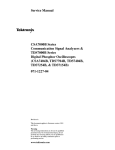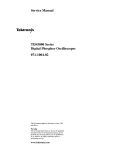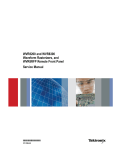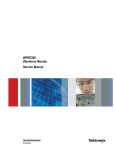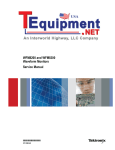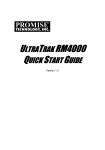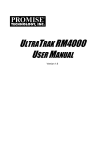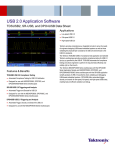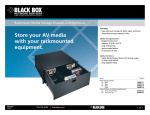Download RM4000 Data Sheet
Transcript
Instructions RM4000 Tektronix 4000 Series Rackmount Kit 071-2134-01 Warning The servicing instructions are for use by qualified personnel only. To avoid personal injury, do not perform any servicing unless you are qualified to do so. Refer to all safety summaries prior to performing service. www.tektronix.com *P071213401* 071213401 Copyright © Tektronix. All rights reserved. Licensed software products are owned by Tektronix or its subsidiaries or suppliers, and are protected by national copyright laws and international treaty provisions. Tektronix products are covered by U.S. and foreign patents, issued and pending. Information in this publication supercedes that in all previously published material. Specifications and price change privileges reserved. TEKTRONIX and TEK are registered trademarks of Tektronix, Inc. Contacting Tektronix Tektronix, Inc. 14200 SW Karl Braun Drive P.O. Box 500 Beaverton, OR 97077 USA For product information, sales, service, and technical support: H In North America, call 1-800-833-9200. H Worldwide, visit www.tektronix.com to find contacts in your area. Service Safety Summary Only qualified personnel should perform service procedures. Read this Service Safety Summary and the General Safety Summary in the product service manual or the instruction manual. Do Not Service Alone. Do not perform internal service or adjustments of this product unless another person capable of rendering first aid and resuscitation is present. To prevent the instrument and rack from falling onto the operator, two or more installers should install the instrument into the rack cabinet. After completing the installation procedure, the installers should verify that the instrument and rack cabinet will not tip forward while the instrument is in the extended position. Disconnect Power. To avoid electric shock, switch off the instrument power, then disconnect the power cord from the mains power. Use Care When Servicing With Power On. Dangerous voltages or currents may exist in this product. Disconnect power and disconnect test leads before removing protective panels, soldering, or replacing components. To avoid electric shock, do not touch exposed connections. RM4000 Rackmount Kit 1 Service Safety Summary 2 RM4000 Rackmount Kit Kit Description This introduction describes the installation of the rackmount kit to your standard bench-top instrument. The rackmount kit is a collection of parts that, once installed, configure the instrument for mounting into a standard 19-inch equipment rack. This document supports Tektronix modification: ECR31404. Products DPO4000 Series MSO4000 Series All Serial Numbers All Serial Numbers Kit Parts List Table 1 lists the parts included in this rackmount kit. The parts are shown in Figure 1. Table 1: RM4000 Rackmount kit (see figure 1 on page 4) Quantity Part number -1 1 each 386-7420-xx PLATE, MOUNTING; RACKMOUNT LEFT -2 1 each 386-7421-xx PLATE, MOUNTING; RACKMOUNT RIGHT -3 2 each 367-0525-xx HANDLE, CARRYING; 0.375 AL, POWDER COAT, PEKING GRAY -4 1 each 386-7466-xx PLATE, SUPPORT; RACKMOUNT TOP -5 1 each 386-7467-xx PLATE, SUPPORT; RACKMOUNT BACK -6 12 each 211-0722-xx SCREW, MACHINE; 6-- 32 X 0.250, PNH, 410 SS PASSIVATED, T-- 15 TORX DR -7 4 each 212-0577-xx SCREW, MACHINE; 10-- 32 X 0.625, TRH, 410 SS, PASSIVATE, POZ -8 4 each 212-0681-xx SCREW, MACHINE; 10-- 32 X 0.25, PNH, 410 SS, PASSIVATE, T25 TORX -9 4 each 361-1832-xx SPACER, RECTANGULAR WASHER .888 X 1.000 X .225 -10 1 each 351-1095-xx SLIDE ASSY; PAIR, W/STD HARDWARE KIT AND REAR BRACKET -11 4 each 211-0734-xx SCREW, MACHINE; 6-- 32 X 0.250, FLH100, 410 SS PASSIVATED, T-- 10 TORX 1 each 071-2134-01 TECH MANUAL: INSTRUCTIONS, RACKMOUNT KIT, TEKTRONIX 4000 SERIES Item --------- RM4000 Rackmount Kit Description 3 Kit Description 2 1 6 11 3 5 4 7 9 8 10 Figure 1: Rackmount kit parts (part appearance may vary) 4 RM4000 Rackmount Kit Kit Description Warranted Characteristics When the instrument is installed according to the instructions in this document, the rackmounted instrument meets all warranted characteristics listed in the instrument specification except for those listed in Environmental Requirements on page 6. Instruments mounted using methods other than those described in these instructions may not meet their warranted characteristics. See the specifications for your instrument model for tables of the warranted characteristics. Cooling air enters on the bottom and right sides as shown in Figure 2. You must provide adequate cool air to meet the ambient temperature requirements listed in Table 2. Hot air out (rear) Measure input air temperature Cool air in Figure 2: Instrument cooling RM4000 Rackmount Kit 5 Kit Description Environmental Requirements The following environmental characteristics supercede those listed in the specifications and performance verification sections of the manual for your instrument. Table 2: Warranted characteristics Characteristic Description Temperature, Inside Rack Cabinet Operating +10 _C to +45 _C (+50 _F to +113 _F) Nonoperating - 22 _C to +60 _C (-- 7.6 _F to +140 _F) Shock Operating and Non-operating 20 g, 11 ms, half sine, each axis, 3 drops each Clearance Requirements The rack in which the rack adapted instrument is mounted must provide the following clearance requirements: H A minimum of 8.75 in (222.25 mm) of vertical space H A minimum width of 17.72 in (450.09 mm) between the left- and right-front rails in the rack H A minimum depth of 12.75 in (323.85 mm) CAUTION. Adhering to these clearance requirements provides the rack-mounted instrument with sufficient clearance for air circulation and accommodation of the power cord and mounting hardware. Failure to provide these clearances can result in overheating and can cause instrument faults or failure. 6 RM4000 Rackmount Kit Kit Description 429.51 mm (16.910 in) 559.56 mm (22.030 in) 179.32 mm (7.060 in) 57.84 mm (2.277 in) 486.03 mm (19.135 in) 480.37 mm (18.912 in) 26.77 mm (1.054 in) 177.80 mm (7.00 in) 218.36 mm (8.597 in) 465.02 mm (18.308 in) Figure 3: Instrument with rack adapter installed RM4000 Rackmount Kit 7 Kit Description 8 RM4000 Rackmount Kit Installation Instructions This section contains the procedures needed to rackmount a DPO4000 or an MSO4000 series instrument. Minimum Tool and Equipment List The following tools are required to attach the rack-adapter kit hardware, install cabling hardware, and mount the rack-adapted instrument into a standard equipment cabinet. All tools are standard tools that are readily available. Table 3: Tools required for rackmount installation Name Description Screwdriver handle (magnetic) Accepts 1/4-inch hexagonal head driver tips No. 2 Phillips or PoziDriv tip Phillips or PoziDriv-driver tip for number 2 size screw heads T-10 TORX tip TORX-driver tip for T-10 size screw heads (flathead) T-15 TORX tip TORX-driver tip for T-15 size screw heads T-25 TORX tip TORX-driver tip for T-25 size screw heads 1/4-inch wrench Wrench or nut driver can be used to install slides Torque driver 6.5 in long shaft; accepts 1/4-inch hexagonal head driver tips These instructions are for qualified service personnel who are familiar with servicing the product. If you need further details for disassembling or reassembling the product, refer to the appropriate product manual. Contact your nearest Tektronix Service Center or Tektronix Factory Service for installation assistance. WARNING. To prevent the rackmounted instrument from tipping forward onto the operator, install the instrument so that the operator will be able to access all of its rear-panel connectors without pushing down on the instrument. Verify that the rack does not become unstable with the instrument fully extended. Do not leave the instrument extended when finished accessing the rear panel. WARNING. To avoid electric shock, disconnect the power cord from the mains power before removing the cover. Failure to do so could result in injury or death. RM4000 Rackmount Kit 9 Installation Instructions Remove Equipment Required: Screwdriver handle with T-15 tip. This procedure prepares the instrument for installation of the rackmount parts. NOTE. Retain all parts removed from the instrument for later use. Some of those parts will be reinstalled as you perform this rack conversion; store the remainder in case reconversion to a standard instrument configuration is desired at a later time. 1. Disconnect the power cord from the rear of the instrument. 2. Remove the four T-15 TORX screws that secure the rear cover to the front case assembly. See Figure 4. 3. Remove the rear cover. Remove 4 screws Front case assembly Rear case cover Figure 4: Removal of rear case cover 10 RM4000 Rackmount Kit Installation Instructions Install Equipment Required: Torque driver with T-15 and T-25 tips. This section describes mounting the rackmount parts to the instrument. NOTE. Rackmount part appearance may vary from the illustrations. 1. Install the left and right mounting plates on the instrument using four 6-32 x 0.250 inch pan head T-15 TORX-drive screws tightened to 8 in-lb. See Figure 5. Front case assembly Left mounting plate Screw Screw Screw Right mounting plate Screw Figure 5: Installing the left and right mounting plates 2. Install the two handles using four 10-32 x 0.25 inch pan head T-25 TORXdrive screws tightened to 16 in-lb. Handles should curve towards the sides of the instrument. See Figure 6. 3. Fasten the back support plate to the left and right mounting plates with four 6-32 x 0.250 inch pan head T-15 TORX-drive screws, lining up the dimples RM4000 Rackmount Kit 11 Installation Instructions in the back support plate with the slots in the mounting plates. Tighten screws to 8 in-lb. See Figure 6. NOTE. The back support plate and top support plate have holes to facilitate mounting optional accessories. For example, Figure 6 shows the TEK-USB-488 GPIB to USB Adapter mounted to the back support with screws. (You can also use nylon straps to mount accessories.) 4. Install the top support plate on the left and right mounting plates using four 6-32 x 0.250 inch flathead T-10 TORX-drive screws tightened to 8 in-lb. See Figure 6. Top support plate Flathead screws (4) Optional accessory Handle (2) Back support plate Screws (4) Screws (4) LIne up Figure 6: Installing the handles, top, and back support 12 RM4000 Rackmount Kit Installation Instructions 5. Remove the front section of each of the two tracks. See Figure 7. Remove this section from each track. Figure 7: Prepare tracks for mounting 6. Install the front left- and right-side track sections on the instrument using four 6-32 x 0.250 inch pan head T-15 TORX-drive screws tightened to 8 in-lb. See Figure 8. Left-- side rack mount Right-- side rack mount Screws (4) Figure 8: Installing the left- and right-side track sections RM4000 Rackmount Kit 13 Installation Instructions WARNING. To ensure that the rackmount track locks, make sure the track button latches are oriented correctly: the right-side latch is located toward the bottom of the rackmount panel and the left-side latch is located toward the top of the rackmount panel. Refer to Figure 9. If the button latches are not oriented correctly the instrument could slide from the rack, which could cause injury or damage to the instrument. Note: Button latch is located near the bottom edge of right-side track, top edge for left-side track. Mount the tracks on the sides of the instrument. Figure 9: Track orientation This completes the installation of the rack-adapter hardware to the instrument. To complete the installation, do the following procedure: Rackmount the RackAdapted Instrument. 14 RM4000 Rackmount Kit Installation Instructions Rackmount the Rack-Adapted Instrument This procedure assembles and installs the slide-out tracks in the equipment rack, and then installs the rack-adapted instrument in the rack. The slide-out tracks permit the rack-adapted instrument to be extended out of the rack for rear-panel and connector maintenance without removing the instrument from the rack. WARNING. To prevent the rackmounted instrument from tipping forward onto the operator, install the instrument so that the operator will be able to access all of its rear devices without pushing down on the instrument. Verify that the rack does not become unstable with the instrument fully extended. Do not leave the instrument extended when finished accessing the rear panel. Install Track Assembly and Instrument into the Rack Equipment Required: One screwdriver handle, one number two PoziDriv tip, and one torque driver. NOTE. The rack hardware kit contains hardware for mounting the instrument in several configurations. Not all of the hardware in the kit will be needed. A standard equipment rack has rails with universal hole spacing. If you use a rack with other than universal hole spacing, you may have to drill additional mounting holes in the rack. Procedure: 1. Assemble the slide-out track: a. Measure the distance between the front and rear rail of the equipment rack. b. Align the rear bracket to the right slide-out track as shown in Figure 10. Note that the rear bracket has multiple pairs of mount-through holes. When aligning the bracket and track, be sure to select a pair of holes that mount the rear bracket so that the flange-to-flange distance matches the distance between the front rail and rear rail measured in step a. c. Using a screwdriver with a number two PoziDriv tip, secure the rear bracket to the right slide-out track using two screws (10-32) and a bar nut as illustrated. Leave the screws loose so that the overall length of the slide-out track assembly can be adjusted when installing it in the rack. d. Repeat steps b and c to assemble the left slide-out track assembly. RM4000 Rackmount Kit 15 Installation Instructions 2. Mount the slide-out track assemblies, using the slide drawer hardware listed in the kit parts list, Figure 1-10: a. Select the mounting position in rack: Select two 0.5 inch-spaced holes in the front rail. Verify that the 4.36 inch and 10.500 inch clearances exist relative to those mounting holes. See Figure 11 on page 17. Rear flange (mounts to rear rail of rack) Bar nut Flange-to-Flange: 514.4 mm (20.25 in) minimum to 673.1 mm (26.50 in) maximum Rear bracket Right slide-out track assembly Outer track Round cut out Front flange (mounts to front rail of rack) Inner track Left slide-out track assembly Figure 10: Assembly of slide-out track assemblies 16 RM4000 Rackmount Kit Installation Instructions Securing holes (tapped for 10-32 screws) 76.2 mm (3.000 in) 12.7 mm (0.50 in) (for correct position of securing holes) 221.488 mm (8.720 in) 111.125 mm (4.375 in) Figure 11: Vertical clearances for rack installation (left-front rail shown) RM4000 Rackmount Kit 17 Installation Instructions b. Select mounting method according to rack type: H To mount the slide-out tracks with their front and rear flanges outside of the front and rear rails, use the mounting method A shown in Figure 12 when doing substep c. Add a bar nut to the installation only if the rails have untapped holes. H To mount with front and rear flanges inside of rails, use the mounting method B outlined in Figure 12. This mounting method assumes untapped holes. c. Install in rack: Using the method and hardware determined from substep b, secure the right slide-out track assembly to its front and rear rails. The screws should be fully, but lightly, seated so mounting can be adjusted later. d. Fix the length of the slide-out track assembly: Tighten the screws, applying 28 inch-lb of torque, left loose in step 1, substep c to fix the front to rear flange spacing of the slide-out track assembly. e. Mount the left slide-out track assembly: Repeat substeps c through d to mount the left slide-out track assembly. Outer track Outer track Use a bar nut if front rails are not tapped Use a bar nut Front flange Front flange Left-front rack rail English 10-32 Pan-head screws (4) # 12 # 10 Metric M6 Left-front rack rail M5 10-32 Flat-head screws (4) 10-32 Pan-head screws (4) Use two flat-head screws if the cabinet rails have countersunk mounting holes; otherwise use two pan-head screws Mounting Method A Mounting Method B Figure 12: Installation of slide-out track assemblies in rack (top view) 18 RM4000 Rackmount Kit Installation Instructions 3. Mount the instrument in the rack: WARNING. To prevent the instrument from tipping or dropping onto the installers, two or more people should install this instrument into the rack cabinet. After completing the installation procedure, the installers should verify that the instrument and rack cabinet will not tip forward while the instrument is in the extended position. a. Install the instrument: H Working from the front of the rack, slide the inner track of each slide-out track assembly until it extends out the front of the rack. Continue to slide them out until they lock. H Insert the left and right tracks that extend from the rear of the instrument into the ends of the tracks just extended. Make sure the tracks mounted on the instrument slip inside the inner tracks extended earlier. H Slide the instrument backwards until it stops. H Push to release the button latches, located on the outside of each track, and continue to slide the instrument all the way into the cabinet. b. Level the rackmounted instrument: RM4000 Rackmount Kit H Tighten the four screws that were left loose at the rear of the rack when you did step 2, substep c, and then pull the instrument part way out of the rack. H Be sure that the four screws that were left loose at the front of the rack are loose enough to allow the slide-out track assemblies to seek their normal positions. H Retighten the four screws and push the instrument all the way into the rack. If the tracks do not slide smoothly, readjust the level using the method just detailed. H When leveling is completed, tighten the 10-32 screws using 28 inch-lb of torque. 19 Installation Instructions Finishing the Installation It is recommended that you secure the instrument to the rack. WARNING. To prevent the rackmounted instrument from sliding forward and causing personal injury or instrument damage, always secure the instrument to the rack if the rack is moved (for example, if the rack is repositioned or relocated to another room). 4. Secure the instrument to the rack: a. Secure the instrument in the rack using four 10-32 x 0.625 in screws and rectangular washer spacers as shown in Figure 13. Rectangular washer spacer (4) Screws (4) Figure 13: Securing the instrument to the rack g 20 End of document g RM4000 Rackmount Kit























